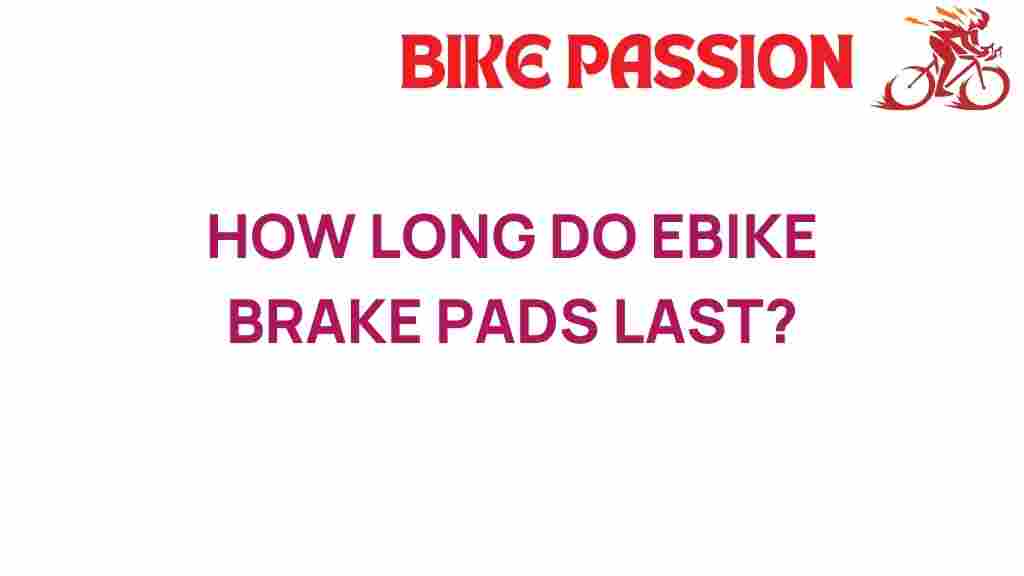The Lifespan of eBike Brake Pads: What You Need to Know
As eBike usage continues to rise, understanding the maintenance of essential components like brake pads is crucial for every cyclist. The lifespan of eBike brake pads affects not only your performance but also your safety on the road. In this article, we will explore the factors that influence the lifespan of brake pads, how to maintain them, signs of wear and tear, and when to consider replacement. Let’s dive deeper into the world of eBike brake pads and get you equipped with the knowledge you need.
Understanding eBike Brake Pads
Brake pads are a critical component of your eBike’s braking system. They are responsible for creating the friction necessary to slow down or stop your bike safely. eBikes often come with different types of brake systems, including:
- **Disc brakes** – Common in modern eBikes, they offer excellent stopping power and performance in various conditions.
- **Rim brakes** – These are typically lighter and easier to maintain but may perform poorly in wet conditions.
- **Hydraulic brakes** – Provide superior stopping power and modulation but can be more complex to maintain.
Each type of brake pad has its own lifespan, influenced by several factors including riding style, terrain, and maintenance habits.
Factors Affecting the Lifespan of eBike Brake Pads
The lifespan of eBike brake pads can vary significantly based on several factors:
- Riding Conditions: Riding in harsh conditions, such as rain, mud, or steep terrains can accelerate wear.
- Weight Load: Heavier loads lead to increased braking force, which can wear out brake pads faster.
- Brake Type: The material of the brake pad (organic, metallic, or semi-metallic) also plays a role in durability.
- Riding Style: Aggressive braking or frequent stops can lead to quicker wear compared to smoother riding.
- Maintenance: Regular maintenance can significantly prolong the lifespan of your brake pads.
Average Lifespan of eBike Brake Pads
On average, eBike brake pads can last between 500 to 2,000 miles, depending on the factors mentioned earlier. Here’s a rough breakdown:
- Disc Brake Pads: 1,000 to 2,000 miles
- Rim Brake Pads: 500 to 1,500 miles
- Hydraulic Brake Pads: 1,000 to 2,000 miles
It’s important to regularly check the condition of your brake pads, especially if you ride frequently.
Signs of Wear and Tear on eBike Brake Pads
Identifying the signs of wear and tear on your brake pads early can prevent accidents and ensure your eBike performs optimally. Look out for the following:
- Visual Inspection: If the brake pad material appears thin or frayed, it’s time for a replacement.
- Squeaking or Grinding Sounds: Unusual noises when braking indicate that the pads may be worn out.
- Reduced Braking Performance: If you notice a decrease in stopping power, check your brake pads immediately.
- Vibration or Pulsation: If you feel vibration in the handlebars when braking, it might be a sign of unevenly worn pads.
Step-by-Step Maintenance of eBike Brake Pads
Proper maintenance can significantly extend the lifespan of your eBike brake pads. Follow these steps:
1. Regular Cleaning
Keep your brake pads clean from dirt and debris. Use a clean cloth and some isopropyl alcohol to wipe them down. This prevents contaminants from affecting performance.
2. Check Alignment
Ensure that your brake pads are properly aligned with the rim or rotor. Misalignment can cause uneven wear and reduced performance.
3. Inspect for Wear
Regularly check the thickness of your brake pads. If they are thinner than 1/8 inch, consider replacing them.
4. Replace When Necessary
If you notice any of the signs of wear mentioned earlier, it’s crucial to replace your brake pads promptly to maintain safety and performance.
Replacing eBike Brake Pads
When it’s time to replace your brake pads, follow these steps:
1. Gather Your Tools
You’ll need the following tools:
- Wrench or Allen key
- New brake pads
- Clean cloth
- Isopropyl alcohol
2. Remove the Wheel
To access the brake pads, you may need to remove the wheel. Use your wrench or Allen key to loosen the axle bolts.
3. Remove Old Brake Pads
Carefully remove the old brake pads from the caliper. Pay attention to how they are positioned as you will need to install the new ones in the same manner.
4. Install New Brake Pads
Insert the new brake pads into the caliper, ensuring they are aligned correctly. Secure them in place.
5. Reassemble and Test
Reattach the wheel and test the brakes before riding. Make sure to check for proper alignment and braking performance.
Troubleshooting Common Brake Pad Issues
Here are some common issues you might encounter with your eBike brake pads, along with troubleshooting tips:
1. Squeaking Brakes
If your brakes squeak, it may be due to dirt on the pads or improper alignment. Clean the pads and check their alignment.
2. Poor Braking Performance
This could indicate worn pads or contaminated pads (e.g., from oil or grease). Inspect your pads and replace them if necessary.
3. Vibration During Braking
Vibration may be a sign of uneven wear or misalignment. Check the installation and condition of your brake pads.
Conclusion
Understanding the lifespan of eBike brake pads is essential for maintaining safety and performance while cycling. Regular maintenance, timely inspections, and knowing when to replace your brake pads can significantly enhance your eBike riding experience. Remember to keep an eye out for signs of wear and tear, and take action when necessary. For more information on eBike maintenance, check resources available at eBike Maintenance Guides.
Taking care of your brake pads not only ensures your eBike performs at its best but also contributes to your overall cycling safety. Happy cycling!
This article is in the category Maintenance and created by BikePassion Team
